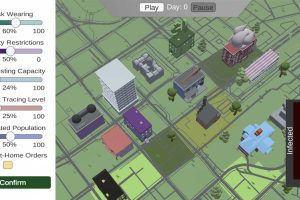
Dense metro areas like New York City and Los Angeles were among the hardest hit in the early days of the COVID-19 pandemic. But it wasn’t long before the disease moved beyond urbanized regions and inundated America’s small towns.
To simulate how COVID-19 spreads through smaller communities and how interventions such as vaccinations and mask-wearing affect the spread of the virus, Johns Hopkins researchers have developed an interactive online platform called “Anytown, USA.”
Anytown, USA is an extension of the Delineo Disease Modeling Project at Johns Hopkins, a multidisciplinary endeavor that aims to create news tools for modeling the spread of pandemics.
Anton Dahbura, associate research scientist in the Department of Computer Science, said the idea for the simulator came from watching the pandemic evolve in his own hometown of Hagerstown, Maryland, and seeing how COVID-19 impacted such smaller towns and communities differently than it affected Washington, D.C. and Baltimore, despite being only an hour away.
“We recognized that the way COVID-19 spreads in small and rural towns is different than how it spreads in large cities, or college towns, or even resort towns. People thought, it’s not going to come here, but in reality, it’s just a matter of time before it spreads everywhere, similar to the flu,” said Dahbura, who is a member of the Malone Center for Engineering in Healthcare and co-director of the Johns Hopkins Institute of Assured Autonomy, as well as the executive director of the Johns Hopkins University Information Security Institute.
Dahbura is collaborating on the project with Kimia Ghobadi, an assistant professor in the Department of Civil and Systems Engineering and a member of the Malone Center.
The simulator models a fictional Midwestern town of about 6,000 inhabitants called Anytown, USA, whose residents commute to work, sweat it out at the gym, and frequent local staples like Bob’s Smokehouse and Ed’s Hardware. The simulation tracks about two months of movement and subsequent transmission, starting with a few COVID-19 infected people who go on to infect others—all depending on parameters such as the percentage of people who wear masks and are vaccinated or capacity restrictions on restaurants and bars.
Users can plug in various circumstances and see their expected effects on coronavirus spread. What might happen if the town has fewer vaccinated residents but more residents who wears masks, for example? In this virtual world, users can visualize how COVID-19 will impact a given city under different scenarios.
Anytown’s creators hope that the tool can support education and public health outreach efforts. For example, teachers can use it to show students how a pandemic can spread in real time, in their own community.
To read the complete story at The Hub, click here.